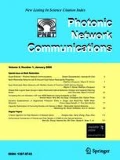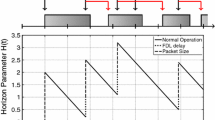Abstract
In an optical burst switching (OBS) network, the blocking time, representing the time interval during which the channel is occupied for a given class of incoming burst, is a key metric for performance evaluation and traffic shaping. In this paper, we study a horizon-based single-channel multi-class OBS node, for which the multiple traffic classes are differentiated using different offset time of each class. By assuming Poisson burst arrivals and phase-type distributed burst lengths and using the theory of Multi-layer stochastic fluid model, we obtain the Erlangian approximation for the finite time probability of the blocking time for a given class of burst in an OBS node. We further propose an explicit algorithm and procedure to calculate the Erlangian approximation. Numerical results are provided to illustrate the accuracy and the speed of convergence of the proposed method.



Similar content being viewed by others
References
Yoo, M., Qiao, C.: Supporting multiple classes of services in IP over WDM networks. In: Global Telecommunications Conference, 1999 (GLOBECOM’99), vol. 1B, pp. 1023–1027 (1999)
Barakat, N., Sargent, E.: An accurate model for evaluating blocking probabilities in multi-class OBS systems. IEEE Commun. Lett. 8(2), 119–121 (2004)
Hernandez, J.A., Aracil, J., de Pedro, L., Reviriego, P.: Analysis of blocking probability of data bursts with continuous-time variable offsets in single-wavelength OBS switches. J. Lightwave Technol. 26(12), 1559–1568 (2008)
Kaheel, A., Alnuweiri, H., Gebali, F.: A new analytical model for computing blocking probability in optical burst switching networks. IEEE J. Sel. Areas Commun. 24(12), 120–128 (2006)
Kankaya, H.E., Akar, N.: Exact analysis of offset-based service differentiation in single-channel multi-class OBS. IEEE Commun. Lett. 13(2), 148–150 (2009)
Vu, H.L., Zukerman, M.: Blocking probability for priority classes in optical burst switching networks. IEEE Commun. Lett. 6(5), 214–216 (2002)
Yazici, M. A., Akar, N.: Analysis of continuous feedback markov fluid queues and its applications to modeling optical burst switching. In: Proceedings of the 2013 25th International Teletraffic Congress (ITC) (2013)
Morato, D., Izal, M., Aracil, J., Magana, E., Miqueleiz, J.: Blocking time analysis of OBS routers with arbitrary burst size distribution. In: IEEE Global Telecommunications Conference, 2003 (GLOBECOM ’03), vol. 5, pp. 2488–2492 (2003)
Morato, D., Aracil, J., Hernandez, J.A., Garcia-Dorado, J.L.: On the blocking time distribution of core OBS switches. Photonic Netw. Commun. 18(3), 314–322 (2009)
Anick, D., Mitra, D., Sondhi, M.M.: Stochastic theory of data handling system with multiple sources. Bell Syst. Tech. J. 61(8), 1871–1894 (1982)
Elwalid, A., Mitra, D.: Analysis and design of rate-based congestion control of high-speed networks, I: stochastic uid models, access regulation. Queueing Syst. 9(1–2), 29–63 (1991)
Foreest, N.D., Mandjes, M., Scheinhardt, W.: Analysis of a feedback fluid model for heterogeneous TCP sources. Stoch. Models 19(3), 299–324 (2003)
O’Reilly, M.M., Palmowski, Z.: Loss rates for stochastic fluid models. Perform. Eval. 70(9), 593–606 (2013)
Badescu, A.L., Breuer, L., Soares, A.D.S., Latouche, A.G., Remiche, M.A., Stanford, D.: Risk processes analyzed as fluid queues. Scand. Actuar. J. 2005(2), 127–141 (2005)
Badescu, A., Drekic, S., Landriault, D.: On the analysis of a multi-threshold Markovian risk model. Scand. Actuar. J. 2007(4), 248–260 (2007)
Lina, X.S., Sendova, K.P.: The compound Poisson risk model with multiple thresholds. Insur. Math. Econ. 42(2), 617–627 (2008)
Ramaswami, V.: Passage times in fluid models with application to risk processes. Methodol. Comput. Appl. Probab. 8(4), 497–515 (2006)
Jones, G.L., Harrison, P.G., Harder, U., Field, T.: Fluid queue models of battery life. In: 19th Annual IEEE International Symposium on Modelling. Analysis, and Simulation of Computer and Telecommunication Systems, pp. 278–285 (2011)
Stanford, D.A., Latouche, G., Woolford, D.G., Boychuk, D., Hunchak, A.: Erlangized fluid queues with application to uncontrolled fire perimeter. Stoch. Models 21(23), 631–642 (2005)
Bean, N.G., O’Reilly, M.M., Sargison, J.E.: Stochastic fluid flow model of the operation and maintenance of power generation systems. IEEE Trans. Power Syst. 25(3), 1361–1374 (2010)
Mandjes, M., Mitra, D., Scheinhardt, W.: Models of network access using feedback fluid queues. Queueing Syst. 44(4), 365–398 (2003)
Ahn, S., Badescu, A., Ramaswami, V.: Time dependent analysis of finite buffer fluid flows and risk models with a dividend barrier. QUESTA 55(4), 207–222 (2007)
Bean, N.G., O’Reilly, M.M.: Performance measures of a multi-layer Markovian fluid model. Ann. Oper. Res. 160(1), 99–120 (2008)
Latouche, G., Ramaswami, V.: Introduction to matrix analytic methods in stochastic modeling. In: ASA SIAM, Philadelphia (1999)
Asmussen, S., Avram, F., Usbel, M.: Erlangian approximations for finite time ruin probabilities. ASTIN Bull. 32(02), 267–281 (2002)
Ramaswami, V., Woolford, D.G., Stanford, D.A.: The erlangization method for Markovian fluid flows. Ann. Oper. Res. 160(1), 215–225 (2008)
Ramaswami, V.: Matrix analytic methods for stochastic fluid flows. In: Teletraffic Engineering in a Competitive World. Proceedings of the 16th International Teletraffic Congress, pp. 1019–1030 (1999)
Author information
Authors and Affiliations
Corresponding author
Additional information
The work described in this paper was supported by National Natural Science Foundation of China (No. 61370107).
Rights and permissions
About this article
Cite this article
Tang, S., Tan, L. Erlangian approximation to finite time probability of blocking time of multi-class OBS nodes. Photon Netw Commun 30, 167–177 (2015). https://doi.org/10.1007/s11107-015-0508-0
Received:
Accepted:
Published:
Issue Date:
DOI: https://doi.org/10.1007/s11107-015-0508-0




